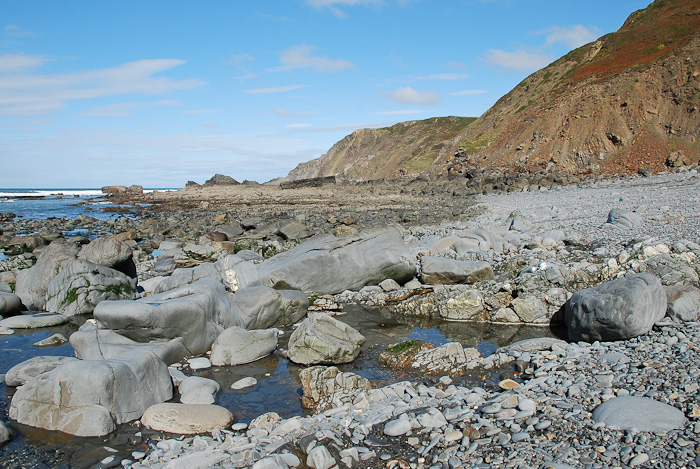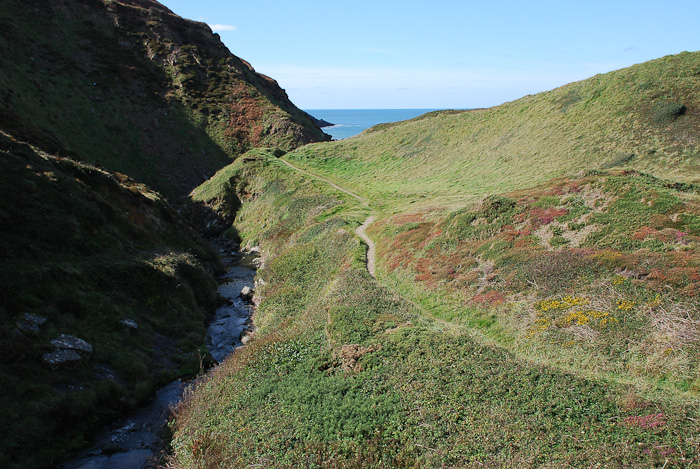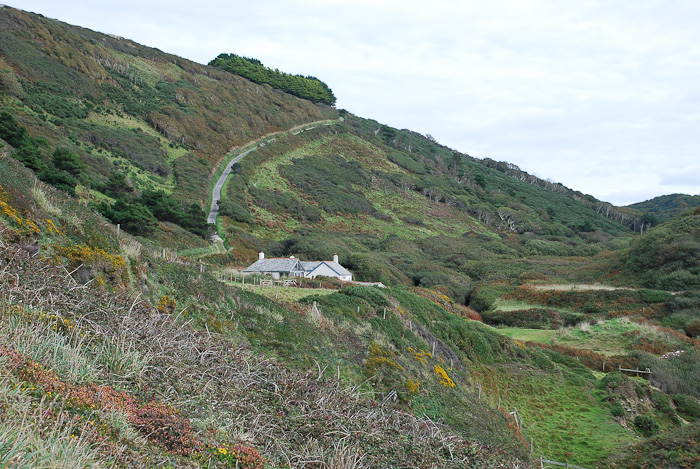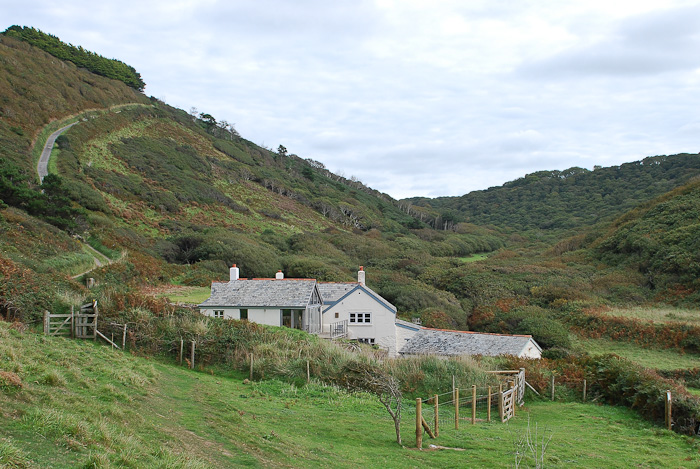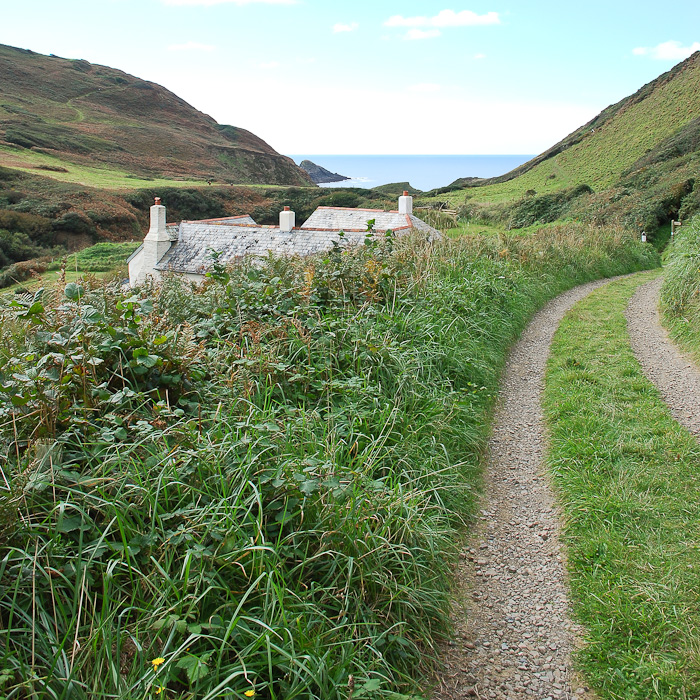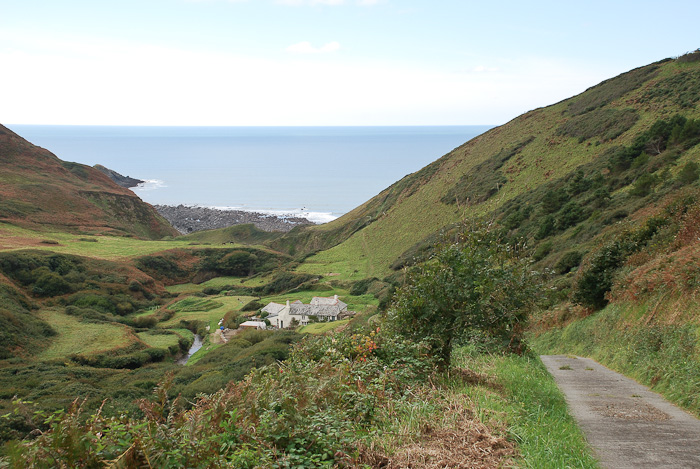Marsland Mouth, Welcombe, Devon.
* * * * *
The stream that runs into the sea at Marsland Mouth is only about three miles long but it rises less than a mile from the source of the river Tamar, forming part of the northern boundary between Devon and Cornwall. The steep-sided and remote valley has been a nature reserve since it was purchased in the 1950s by Christopher Cadbury and is now looked after by the Cornwall and Devon Wildlife Trusts.
* * * * *
‘And even such are those delightful glens, which cut the high table-land of the confines of Devon and Cornwall, and opening each through its gorge of down and rock, towards the boundless Western Ocean. Each is like the other, and each is like no other English scenery. Each has its upright walls, inland of rich oak-wood, nearer the sea of dark-green furze, then of smooth turf, then of weird black cliffs, which range out right and left far into the deep sea, in castles, spires, and wings of jagged iron-stone. Each has its narrow strip of fertile meadow, its crystal trout stream winding across and across from one hill-foot to the other; its gray stone mill with the water sparkling and humming round the dripping wheel; its dark rock pools above the tide mark where the salmon-trout gather in from their Atlantic wanderings, after each autumn flood; its ridge of blown sand, bright with golden trefoil and crimson lady’s finger; its gray bank of polished pebbles, down which the stream rattles towards the sea below. Each has its black field of jagged shark’s-tooth rock which paves the cove from side to side, streaked with here and there a pink line of shell sand, and laced with white foam from the eternal surge, stretching in parallel lines out to the westward, in strata set upright on edge, or tilted towards each other at strange angles by primeval earthquakes. Such is the “Mouth”, as these coves are called; and such the jaw of teeth which they display, one rasp of which would grind apart the timbers of the stoutest ships. To landward, all richness, softness, and peace; to seaward, a waste and howling wilderness of rock and roller, barren to the fisherman, and hopeless to the shipwrecked mariner.
In only one of these “mouths” is a landing for boats made possible by a long sea-wall of rock, which protects it from the rollers of the Atlantic; and that mouth is Marsland, the abode of the White Witch, Lucy Passmore…’
From Westward Ho! by Charles Kingsley
In 1856, Robert Stephen Hawker, Vicar of Morwenstow, wrote:
‘It was a bright, fierce, stern dog-day. I was returning from Wellcombe on my old grey mare. I had to cross a deep and narrow Gorge between hills, like Stowe valley without its cottages or woods, and to pass, down near the sea, a silent mill. On Sundays it is always shut up and the people go elsewhere to sleep. Often as I have passed the all-but-ruined hut, I have thought of the psalm wherein mention is made of the ‘thing which walketh in darkness and the demon of the noon’. That day the sky was silent with heat and the whole scene was so lonely that hardly God was there; when all at once a swift, brown, rough shape started up among the gorsebushes and rushed or glided towards the stream. I felt myself flush and then grow pale; but remembering St Thomas’s word that every spirit must crouch to the Sign, I made it in the air and rode as fast as I could urge the mare towards it. I saw its head disappear down the bank and although I looked along the river and followed its course, I caught sight of it no more. It was a kind of nameless and indefinable sensation rather than the sight that assured me it was preternatural; at least I thought and think so.’
West Mill, Welcombe, Devon
* * * * *
From the 1937 to the end of his life, the writer Ronald Duncan, lived at Welcombe, first at West Mill and later at Home Farm. He was hugely productive and his published and unpublished work encompasses poetry, plays, opera librettos and journalism. He wrote a number of books and articles about his life as well as three controversial autobiographies which describe his relationships with contemporaries, including T. S. Eliot, Ezra Pound and Benjamin Britten.
‘The beach was only two hundred yards from the mill. Wild sage and thyme made the cliffs smell like a Harris tweed. The land had been entirely abandoned to rabbits; the small trout stream was leased by a heron, and poised buzzards overlorded all.’
From Where I Live, by Ronald Duncan.
* * * *
In his autobiography, Personal Record, the writer Gerald Brenan describes how he and his wife, Gamel Woolsey, came to Welcombe in May 1937, A house called Ley Park became their summer place for the next fourteen years, and Gerald and Gamel made two life-long friends in Ronald Duncan and his wife, Rose-Marie. Gerald describes them as living in ‘the most primitive style, collecting their timber and firewood from the beach and carrying their milk and groceries down the steep hill from the village’.
The painter, Dora Carrington, rented West Mill with her future husband, Ralph Partridge, in the summer of 1919. On 14 July 1919 she wrote to Lytton Strachey:
‘Dearest, Twenty times a day I wish you were here! One can’t tell ever what would have happened. But I feel now that it would have been worth while almost to engage this cottage for three months just on the chance of being able to come with you!
Well you shall know what I’ve done since Friday. On Saturday we went to shop and bought food. That took most of the morning, walking up and down innumerable valleys. One’s memory fails one horribly remembering those depths. Such a lunch at the Bush Inn, Morwenstow, for 1/3, cream, saffron buns, and black-a-berrie jam. Then I went after tea to see the Boxes. On the path down the hill Mrs Box appeared driving the cows; she held up both her arms and waved them, with a stick in one hand. And then she ran towards me! It was delightful to see her again. She is still full of vigour and every day she fetches the cows from the marshes by the cottage and takes them back to the farm! And she is 72!’
Mrs Box was the sister-in-law of Mrs Cottle of Home Farm, Welcombe, with whom Gerald Brenan and Gamel feasted on generous helpings of cream and butter, legs of lamb and roast chicken, and gooseberry and blackberry-and-apple tarts during their summer visits in the 1930s and 1940s. Carrington’s portrait of her is now in the Cecil Higgins Art Gallery, Bedford.
A film, Carrington, directed by Christopher Hampton in 1995, is available on DVD. Based on Michael Holroyd’s biography of Lytton Strachey and starring Emma Thompson as Carrington it tells the story of her tangled relationships with the the writers and artists of the Bloomsbury Group.
Home Farm is currently offering guided/independent walking holidays, with a choice of B+B or self-catering accommodation: the guided walks include a Thomas Hardy one around Boscastle, St Juliot and the Valency Valley.
LINKS
– Robert Stephen Hawker: his life and work
– Ronald Duncan Literary Foundation
– Gerald Brenan and Gamel Woolsey in Devon
FURTHER READING
Gerald Brenan (1894 – 1987), Personal Record 1920 – 1972, published1975.
Dora Carrington (1893 – 1932), Carrington: Letters and Extracts from her Diaries edited by David Garnett, published 1970
Ronald Duncan (1914 – 1982), Where I Live, published 1953
Hawker of Morwenstow: Portrait of a Victorian Eccentric, by Piers Brendon, published 1975
Robert Stephen Hawker (1803 – 1875), The Life and Letters of R. S. Hawker edited by C. E. Byles, published 1906
Charles Kingsley (1831 -1875), Westward Ho!, published 1855
Lytton Strachey (1880 – 1932), Lytton Strachey: a Biography, by Michael Holroyd, published 1994
Gamel Woolsey (1895 – 1968), One Way of Love, published 1987
